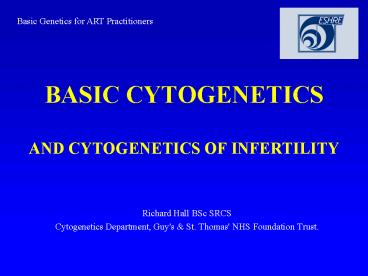BASIC CYTOGENETICS AND CYTOGENETICS OF INFERTILITY - PowerPoint PPT Presentation
1 / 36
Title:
BASIC CYTOGENETICS AND CYTOGENETICS OF INFERTILITY
Description:
7% mosaic e.g. 45,X/46,XX. 45% structural abnormality e.g.46,X,i(X)(q10) ... Mosaics 47,XXY/46,XY may have milder phenotype and may be fertile ... – PowerPoint PPT presentation
Number of Views:1069
Avg rating:3.0/5.0
Title: BASIC CYTOGENETICS AND CYTOGENETICS OF INFERTILITY
1
BASIC CYTOGENETICSAND CYTOGENETICS OF
INFERTILITY
Basic Genetics for ART Practitioners
- Richard Hall BSc SRCS
- Cytogenetics Department, Guy's St. Thomas' NHS
Foundation Trust.
2
CHROMOSOMES ?
- The most important objects in the living world,
for the genes they carry determine the existence
and form of organisms
3
G-banded Karyotype
4
CYTOGENETICS ?
- The study of the genetic constitution of cells
through the visualisation and analysis of
chromosomes. - G-banding
- (and other traditional techniques)
- Fluorescence in situ hybridization (FISH)
- Molecular techniques
- (QF-PCR, MLPA)
5
CHROMOSOME ANALYSIS TECHNIQUES
6
Preparation of Metaphases
CULTURE
SYNCHRONISE
HARVEST
72 HOURS TO 14 DAYS
ANALYSE CHROMOSOMES
STAIN SLIDES
PREPARE SLIDES
7
TRADITIONAL MICROSCOPY
METAPHASE
LOW POWER x100
HIGH POWER x1000
8
TRADITIONAL MICROSCOPY
High power (1000x) view. Next stage of analysis
involves locating each chromosomes pair and
comparing them band for band. Random
distribution of chromosomes can hinder the
accuracy and efficiency of the band comparison.
Typically 1000 bands per cell.
9
CHROMOSOME ABNORMALITIES
- ANEUPLOIDY
- too many chromosomes
- too few chromosomes
- REARRANGEMENTS
- translocations
- balanced
- unbalanced
- Inversions
10
CHROMOSOME ABNORMALITIES
- Chromosome abnormalities seen in adults referred
for - Infertility -
- MOSTLY SEX CHROMOSOME ANEUPLOIDY
- REARRANGEMENTS INVOLVING SEX CHROMOSOMES
- Recurrent Miscarriage
- BLANCED CHROMOSOME REARRANGEMENTS
- E.g. translocations and inversions
2.5
6
HOWEVER UPTO 50 OF FIRST TRIMESTER LOSS IS DUE
TO FETAL CHROMOSOME ABNORMALITY MOSTLY DE NOVO
11
SPONTANEOUS ABORTION PRODUCTS
15 first trimester pregnancies are lost
50 ABNORMAL
50 NORMAL
12
Aneuploidy
- Mostly from meiotic non-disjunction
- Meiosis is the specialised cell division which
generates haploid gametes - Errors in meiotic segregation occur frequently in
human females especially in MI
13
Chromosome abnormalities and maternal age
14
MEIOSIS I NON-DISJUNCTION
MEIOSIS I
MEIOSIS II
DISOMIC
NULLISOMIC
15
Mosaicism
- The presence of two or more cell-lines that are
genetically identical, except for the chromosomal
difference between them, in a single zygote - Frequently seen in patients with sex chromosome
aneuploidy - Abnormal cell line may be in the minority
16
Anaphase lag loss of one X
Mosaicism
47,XXY
46,XY
47,XXY
47,XXY
47,XXY
46,XY
46,XY
47,XXY/46,XY
17
TURNER SYNDROME
High mortality in first trimester fetuses oedema
of extremities coarctation of the aorta webbed
neck
Classical karyotype 45,X (45)
18
TURNER SYNDROME
- Phenotype very variable, often mild and dependant
on karyotype - short stature
- increased carrying angle
- Infertility
7 mosaic e.g. 45,X/46,XX 45 structural
abnormality e.g.46,X,i(X)(q10)
19
Structural abnormalities of theX-chromosome
Monosomy for short arm is associated with
features of Turner syndrome or primary ovarian
failure
The location of the breakpoint in the X may
influence gonadal function
Partial monosomy for, or balanced rearrangements
with breakpoint in long arm more likely to be
associated with premature ovarian failure
20
Structure of the X Chromosome
- Xp11.2-p22.1
- Ovarian failure (gonadal dysgenesis)
- Xq13
- X inactivation centre (XIST)
- Xq13-q26
- critical region for ovarian function
- Breakpoints within this region are associated
with gonadal insufficiency - Except breakpoints in Xq22
21
Klinefelter Syndrome
- Incidence 1/1000
- Usually taller than average
- Disproportionately long limbs
- 30-50 gynaecomastia
- Infertility / Azoospermia
- I.Q may be reduced relative to sibs
Example karyotypes 47,XXY 47,XXY/46,XY
22
Klinefelter Syndrome
- Phenotype very variable some patients are not
diagnosed until they try for a family - Mosaics 47,XXY/46,XY may have milder phenotype
and may be fertile - Therefore always carry out mosaicism check as
infertility is the main clinical problem
23
CHROMOSOME TRANSLOCATIONS
- Exchange of material between chromosomes
- 2 types
- Robertsonian
- Reciprocal
24
NORMAL MALE KARYOTYPE 46,XY
Acrocentric chromosomes
25
ROBERTSONIAN TRANSLOCATIONSder(1421)(q10q10)
26
Robertsonians and Infertility
- Some male carriers are infertile as they have
spermatogenic arrest - Thought to be due to failure of pairing of the
translocation in meiosis which allows it to
interfere with the X-Y bivalent - The more often this occurs the greater the effect
on the sperm count - prevalence of 1 in 1000
- 10x excess of Robs in infertile men
27
Robertsonians and Miscarriage
Behaviour at meiosis
Female carriers of der(1421) have 10 risk of
Down syndrome child
alternate segregation
adjacent segregation
28
(No Transcript)
29
ROBERTSONIAN TRANSLOCATIONS -
- Summary
- result from fusion of two acrocentric chromosomes
(13, 14, 15, 21, 22) - prevalence of 1 in 1000
- balanced carriers have reproductive risks
present as - recurrent miscarriages
- Patau syndrome
- Down syndrome
- male infertility
30
RECIPROCAL TRANSLOCATIONS
- exchange of material between two non-homologous
chromosomes - prevalence of 1 in 500
- balanced carriers are generally phenotypically
normal - Reproductive consequences because of behaviour at
meiosis
31
Behaviour at meiosis
- The homologous chromosomes cannot pair properly
- Instead they must form a quadrivalent
32
Alternate segregation
33
Adjacent-1 segregation
34
RECIPROCAL TRANSLOCATIONSREPRODUCTIVE RISKS
- for most translocations, 50 of conceptions will
have either normal chromosomes or the balanced
translocation - unbalanced products result in
- miscarriage (large segments)
- dysmorphic delayed child (small segments)
35
RECIPROCAL TRANSLOCATIONS
- Summary
- Chromosome rearrangements are rare, but
chromosome analysis is indicated if a couple have
had 3 or more miscarriages of unknown aetiology - Essential that both partners are investigated as
either the male or the female could carry a
balanced rearrangement - Aneuploidy is the most common chromosomal cause
of early miscarriage and requires no follow-up
36
Suggested reading
- Gardner, RJM. Sutherland GR. (2004). Chromosome
abnormalities and genetic counseling. 3rd Ed.
Oxford University Press, New York.































